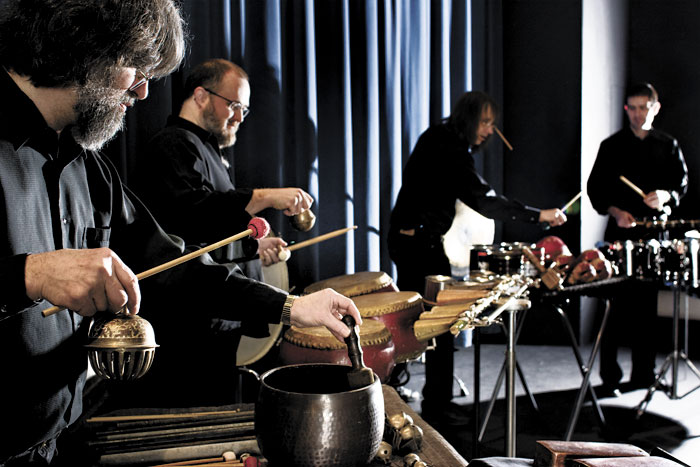The big music story in Seattle on Friday, December 9, 1938, was the upcoming performance of The Queen of Sheba, an opera by Brahms contemporary Karl Goldmark, which earned several news items and enthusiastic reviews in both the Seattle Post-Intelligencer and the Seattle Daily Times. But considerably less notice was taken of an event that night which would prove far more consequential not only to Seattle but to contemporary music in general.
The P-I ran only three bemused but non-judgmental paragraphs about this event, a recital at Cornish College organized by young faculty member John Cage. The Times took perhaps a more tongue-in-cheek view (in one sentence tacked to the end of a three-column review of The Pirates of Penzance, which mentioned the names not only of the cast and crew but of the ushers): “Animated talk can be expected at the reception which will follow the concert in the Cornish Theatre this evening, for the program is to be of modern American percussion music.”
Neither paper reviewed the concert, despite the fact that Cage’s band constituted, as Cornish’s Matt Kocmieroski puts it, “the first ongoing percussion ensemble in the Western music tradition.” But notice is being taken now. The 70th anniversary of that concert will be commemorated next month in “Drums Along the Pacific,” a weekend festival devoted to Cage (who died at age 79 in 1992) and the two other composers most closely associated with his pathbreaking series.
At Cornish, Cage actually worked in the dance department, as an accompanist for Bonnie Bird, a Martha Graham Company alumna. On the recommendation of Bay Area composer Lou Harrison, Bird took Cage on for what would prove a brief (just two years, 1938–40) but intense period of far-reaching innovation. Drawn to explore rhythm—of all musical elements, naturally, the one most significant for dance—Cage formed his percussion ensemble from dancers, including his Alaskan wife Xenia and a teenager from Centralia named Merce Cunningham. He assumed, and soon confirmed, they could handle his music’s complex beats more easily than classically-trained percussionists, and gathered a large, colorful group of standard and found instruments for them, from sleighbells to rice bowls, xylophone to washtub.
After their first 1938 concert, Cage and his ensemble toured the Northwest, and the title “Drums Along the Pacific” comes from Henry Cowell’s admiring article about the tour for the magazine Modern Music. A mentor to both Cage and Harrison, Cowell was himself a pioneering iconoclast: His early piano pieces, like The Banshee (1925), exploded the piano’s sound palette by requiring the player to scrape, pluck, and strum the strings directly. Cowell’s music will open next month’s festival, four concerts featuring the Seattle Chamber Players, pianist Stephen Drury, vocalists John Duykers and Jessika Kenney, and many more musicians. The Cowell program will include The Banshee, unpublished songs, and percussion pieces—like 1934’s Ostinato pianissimo, which first intrigued Cage, and 1939’s Return (written, as Cowell put it, for “three percussors and wailer”).
Harrison retained close ties to Cornish, visiting for concerts and residencies until his own death in 2003. Like many later West Coast composers, he defiantly looked across the Pacific, to Asia rather than Europe, for inspiration, especially to the delicate timbres and refreshingly flavorful modes of the gamelan, the traditional Javanese metal-percussion orchestra. Harrison adapted Javanese musical elements for Western instruments, and his hybrid music is the subject of the festival’s second concert—for example, his Concerto in slendro (1961), named for a traditional gamelan scale and composed for violin and a sparkling ensemble of percussion, celesta, and two tack-pianos (metal pins in place of the usual felt-covered hammers provide a crisp glitter).
The final two concerts will be devoted to Cage, with music from his Cornish days and beyond. They will include Imaginary Landscape #1, a piece for turntables and instruments composed with the help of the in-house Cornish radio station. Amores uses a prepared piano—one with sound-altering bolts, erasers, and other items inserted between its strings, which Cage invented for a dance recital on Cornish’s small stage when no room for more musicians was available. With its gentle pings and thuds, it’s basically a one-man percussion ensemble—a synthesis of Cowell’s inside-the-piano work and Harrison’s gamelan enthusiasm. Of Cage’s later work, his joyously raucous Third Construction for percussion quartet (1941) will contrast with the Zen quiescence of Ryoanji (1985), named for a Kyoto sand-and-stone garden.
Very few composers can claim credit for even one landmark innovation over their career, but Cage managed three at Cornish alone: his percussion ensemble, his radio/electronic pieces, and his prepared piano. His presence established Cornish’s tradition of encouraging musical exploration, and his influence endures in musicians like Kocmieroski and flutist Paul Taub, faculty composer Janice Giteck, and alumni Joshua Kohl and Haruko Nishimura and their Degenerate Art Ensemble. Though it’s been remodeled since, Cornish’s PONCHO Concert Hall, the site of this festival, is the same theater Cage performed in, and Taub, one of the festival’s producers, feels this resonance: “All of the faculty at Cornish, and a number of the students, really feel a strong tie to this history,” he says. “It’s part of the history I’m a part of now.”







